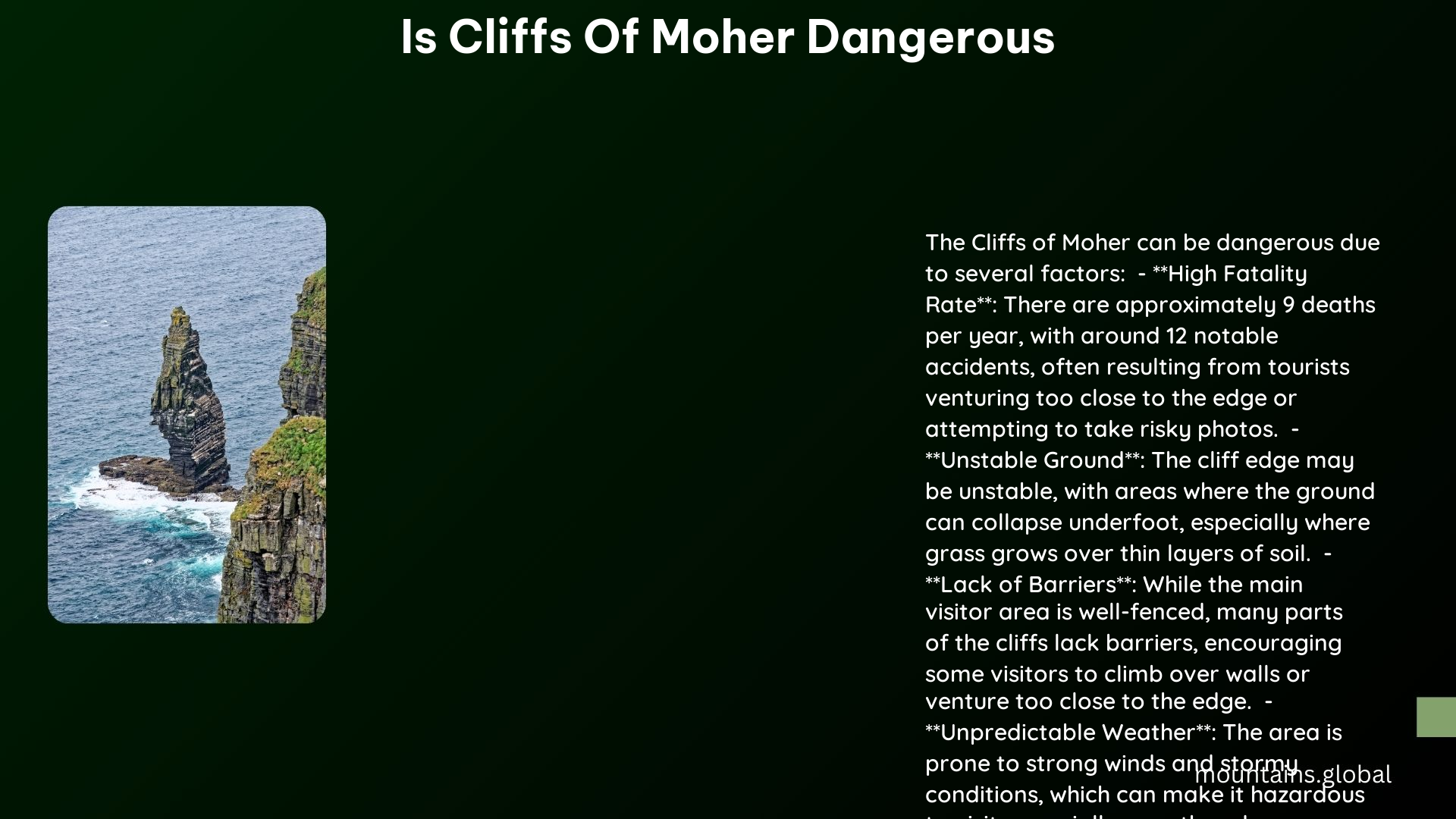The Cliffs of Moher, a stunning natural wonder in Ireland, attract millions of visitors annually. However, this breathtaking site poses significant safety risks. From unstable terrain and steep drops to unpredictable weather conditions, visitors must exercise caution. While the cliffs offer unparalleled views, the lack of barriers in some areas and the temptation to venture off designated paths can lead to dangerous situations. This article explores the potential hazards and provides essential safety tips for those planning to visit this iconic Irish landmark.
What Are the Main Dangers at the Cliffs of Moher?

The Cliffs of Moher, while awe-inspiring, present several potential hazards to visitors. Understanding these risks is crucial for a safe and enjoyable experience:
- Steep Drops: The most obvious danger is the sheer height of the cliffs, which rise up to 214 meters (702 feet) above the Atlantic Ocean.
- Unstable Terrain: Parts of the cliff edge are prone to erosion and can be unstable.
- Strong Winds: Gusts can be powerful enough to knock a person off balance, especially near the edge.
- Slippery Surfaces: Rain and sea spray can make paths treacherous.
- Fog and Poor Visibility: Sudden weather changes can disorient visitors.
- Unofficial Paths: Venturing off designated trails increases the risk of accidents.
How Often Do Accidents Occur at the Cliffs?

While exact statistics are not readily available, accidents at the Cliffs of Moher do occur, some of which have been fatal. Here’s what we know:
- Several deaths have been reported over the years, often due to falls from the cliff edge.
- Rescue operations are not uncommon, with the Irish Coast Guard responding to incidents regularly.
- Most accidents occur when visitors ignore safety warnings or take unnecessary risks for photographs.
It’s important to note that while accidents happen, they are relatively rare considering the high number of annual visitors (approximately 1.5 million).
What Safety Measures Are in Place?
The Cliffs of Moher Visitor Experience has implemented several safety measures to protect visitors:
- Designated Walkways: Official paths are set back from the cliff edge.
- Safety Barriers: In some areas, particularly near the visitor center.
- Warning Signs: Placed strategically to alert visitors of potential dangers.
- Visitor Center Information: Safety briefings and guidelines are provided.
- Staff Patrols: Employees monitor the area and provide assistance.
- Weather Warnings: Updates on potentially hazardous conditions.
How Can Visitors Stay Safe?
To ensure a safe visit to the Cliffs of Moher, follow these essential guidelines:
- Stay on official paths and behind safety barriers.
- Keep a safe distance from the cliff edge, at least 5 meters (16 feet).
- Wear appropriate footwear with good grip.
- Be aware of weather conditions and dress accordingly.
- Hold children’s hands and keep them close at all times.
- Avoid visiting during extreme weather events.
- Don’t attempt to climb or descend the cliffs.
- Respect all warning signs and staff instructions.
What Should Visitors Do in Case of an Emergency?
In the event of an emergency at the Cliffs of Moher:
- Call 112 or 999 immediately for emergency services.
- Alert staff members if you’re near the visitor center.
- Provide clear information about your location and the nature of the emergency.
- Stay calm and follow instructions from emergency responders.
- If safe to do so, remain with any injured persons until help arrives.
Are There Safer Alternatives to View the Cliffs?
For those concerned about safety, there are alternative ways to experience the Cliffs of Moher:
- Visitor Center Viewing Platform: Offers spectacular views from a safe, enclosed area.
- Boat Tours: View the cliffs from sea level, providing a different perspective.
- O’Brien’s Tower: A historic tower with panoramic views from a secure vantage point.
- Doolin Cliff Walk: A guided tour with experienced local guides.
- Hag’s Head: A less crowded area with stunning views, but still requires caution.
What Time of Year Is Safest to Visit?
While the Cliffs of Moher can be visited year-round, some seasons offer safer conditions:
| Season | Safety Level | Considerations |
|---|---|---|
| Summer | Moderate | Crowded, but generally better weather |
| Spring | Good | Mild weather, fewer crowds |
| Autumn | Good | Mild weather, beautiful colors |
| Winter | Challenging | Strong winds, rain, and potential fog |
Spring and autumn generally offer the best balance of good weather and smaller crowds, potentially making for a safer visit.
How Does Weather Affect Safety at the Cliffs?
Weather plays a crucial role in safety at the Cliffs of Moher:
- Wind: Strong gusts can be dangerous near the edge.
- Rain: Makes paths slippery and increases the risk of falls.
- Fog: Reduces visibility, making it easy to lose orientation.
- Sunshine: While pleasant, can cause glare and make it difficult to see the edge clearly.
Always check the weather forecast before visiting and be prepared to adjust your plans if conditions are unfavorable.
What Equipment Should Visitors Bring for Safety?
To enhance safety during your visit, consider bringing the following:
- Sturdy, non-slip footwear
- Waterproof jacket and pants
- Warm layers (even in summer)
- Sun protection (hat, sunglasses, sunscreen)
- Fully charged mobile phone
- Water and snacks
- Small first aid kit
- Flashlight (in case of unexpected delays)
Are There Any Restricted Areas Visitors Should Know About?
Certain areas at the Cliffs of Moher have restricted access for safety reasons:
- Unofficial paths near the cliff edge
- Areas marked with warning signs or barriers
- Sections undergoing maintenance or conservation work
- Wildlife nesting areas during breeding seasons
Always respect these restrictions and stay within designated visitor areas.
How Do Guided Tours Enhance Safety?
Opting for a guided tour can significantly improve safety at the Cliffs of Moher:
- Expert Knowledge: Guides are familiar with safe viewing areas and potential hazards.
- Group Safety: Staying with a group reduces the risk of getting lost or wandering into dangerous areas.
- Weather Insights: Guides can interpret weather conditions and adjust the tour accordingly.
- Emergency Preparedness: Professional guides are trained in first aid and emergency procedures.
- Educational Experience: Learn about the cliffs’ geology and history while staying safe.
Consider booking a reputable guided tour for a safer and more informative visit to the Cliffs of Moher.
In conclusion, while the Cliffs of Moher can be dangerous, following safety guidelines and using common sense can greatly reduce risks. The breathtaking beauty of this natural wonder can be safely enjoyed with proper precautions and respect for the environment. Remember, your safety is ultimately your responsibility, so stay alert, follow the rules, and enjoy the magnificent views from secure vantage points.
References:
1. How to Avoid All the Tourists at the Cliffs of Moher in Ireland
2. Stay Safe When Visiting the Cliffs of Moher
3. Cliffs of Moher safety
